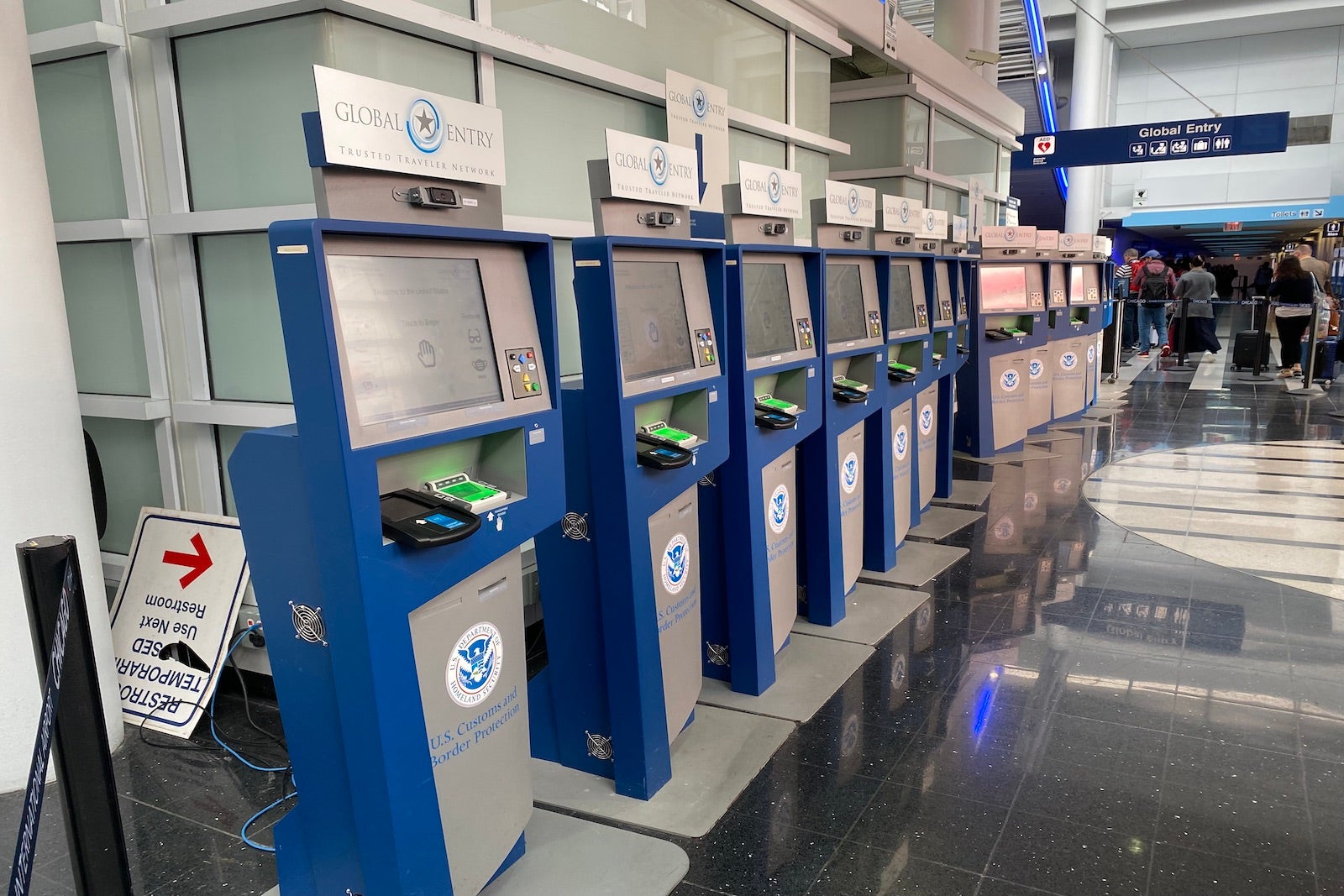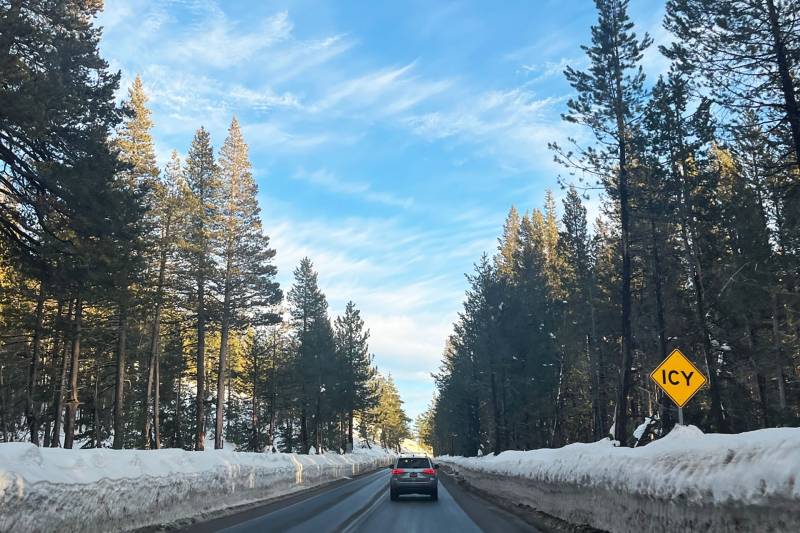
Editor’s note: This is a recurring post, regularly updated with new information.
If you’re a frequent traveler like we are at TPG, you’ve likely come to depend on Global Entry as a way to return to the U.S. without having to wait in the oftentimes long U.S. Customs and Border Protection line.
Global Entry can help you clear customs in a matter of minutes — sometimes before even physically reentering the U.S., if you’re departing from pre-clearance locations in places like Canada.
The process of becoming a Global Entry member can be cumbersome due to the difficulty of securing an in-person appointment. However, enrolling in the program is still worthwhile. Although it launched over a decade ago, it’s since evolved, especially post-COVID-19.
Here’s what to know about applying for or renewing your Global Entry, including how to get application fees reimbursed, what to expect during the interview process, how to use it and how to deal with potential delays.
Using credit cards to get Global Entry for free
Though CBP charges a $100 nonrefundable application fee for Global Entry, many credit cards will reimburse these fees via a credit issued once every four years since a Global Entry membership lasts for five years. You can also use this credit to cover memberships for friends and family members in the event you have access to more credits than you need.
A variety of low-fee and premium cards offer this benefit, including:
As previously mentioned, most of the credit cards that offer an application fee waiver also allow you to cover a Global Entry membership for someone else. So, if you have an unused Global Entry credit on your Amex Platinum, you could charge another person’s Global Entry fee to your card to reimburse the purchase.
Tips for getting a Global Entry interview appointment
Once you’ve applied and are conditionally approved for Global Entry, the next step is to set up your Global Entry interview appointment. Don’t get too excited, though, as Global Entry interviews have been difficult for many to secure due to an ongoing application backlog.
Sign up for our daily newsletter
For example, even though I was conditionally approved for Global Entry in August, I wasn’t able to secure an interview at my home airport until December 2022.
Per the CBP scheduler, the soonest available appointments at the time of publication were at non-airport enrollment centers in Arizona, Michigan and Texas.
However, surprisingly, there were upcoming appointments available in major cities and airports, including Los Angeles, Chicago, New York City, Philadelphia and Washington, D.C.
1 of 5
U.S. CUSTOMS AND BORDER PROTECTION
What to expect during your Global Entry interview
When your Global Entry interview day arrives, be sure to arrive on time and bring a valid passport(s) or permanent resident card, along with proof of residency, such as a driver’s license with your current address, a mortgage statement or a recent utility bill.
Once at the facility, you may have to wait a bit if the CBP officers are busy. If you’re lucky, you may not wait at all, which was the case for me at Chicago’s O’Hare International Airport (ORD) in December.
The interview should not take more than 10 to 15 minutes, during which you’ll be asked a few questions verifying your identity and related to your application, including your recent travel history. The final step is to give fingerprints and get your photo taken.
You should receive your Global Entry card seven to 10 days after your interview, along with your Known Traveler Number, which can be used for both Global Entry and TSA PreCheck since Global Entry includes membership to TSA PreCheck.
Don’t forget to activate your card within 30 days of receiving it, although CBP says you don’t need your physical card to pass through Global Entry kiosks at the airport.
How to use the Global Entry kiosk
Once you’re approved, using the Global Entry lane to reenter the country should be relatively easy.
From that point, how the kiosk works may depend on where you are. Historically, you would use your fingerprints, answer questions, take a photo and then hand the printout you receive to a CBP officer.
However, in some locations, that process has evolved to where you don’t do much of anything other than let the machine scan your face in a paperless Global Entry process.
Parents should note that very young children who are Global Entry members may be too squirmy to scan reliable fingerprints. If you receive a crossed-out printout, show that to the CBP officer.
Enjoying TSA PreCheck as a perk of Global Entry
As mentioned above, a five-year membership to Global Entry also includes five years of access to TSA PreCheck so long as you add your Known Traveler Number to your airline reservations at the time of booking. You can also add it when checking in for your flight online or at the airport.
Though I’ve never personally been denied TSA PreCheck, it is not 100{d8a8d447f05f03c64398acf0d3c5a745c9c41fc784ba89cd5aecd37177dc7d51} guaranteed for every single flight. In any case, you should have TSA PreCheck almost all of the time you have Global Entry — as long as the name matches the ticket and you’ve entered your membership numbers into your ticket purchase or frequent flyer account(s).
US citizenship isn’t required to use Global Entry
Global Entry is available to non-U.S. citizens and permanent residents. Currently, citizens of Argentina, Brazil, Bahrain, India, Colombia, Germany, the Netherlands, the United Kingdom, Panama, South Korea, Switzerland, Singapore, Taiwan and Mexico can apply.
Canadian citizens and residents are also eligible through the Nexus program, which provides pre-screened travelers with expedited processing services when entering the U.S. and Canada by plane, car or boat. It also provides access to Global Entry kiosks when arriving via one of eight Canadian Preclearance airports in Ontario, Quebec, British Columbia, Manitoba, Nova Scotia and Alberta.
If you’re a U.S. citizen thinking about getting Global Entry and you visit Canada often, you may want to consider getting Nexus so you can also enjoy expedited customs when entering there. Clearing Canadian customs and immigration can take a while, especially at certain airports. Once you have it (as a U.S. citizen or permanent resident), you also get Global Entry and TSA PreCheck.
Nexis is half the cost of Global Entry ($50 per adult and free for children younger than 18). Know that you must go to an enrollment center along the Canadian border to enroll in the program.
For more information about how citizens from other countries can apply for and get approved for Global Entry — such as the application process for U.K. citizens, which involves registering through the U.K. government website and paying a fee of 42 euros ($42.72) before applying through the U.S. Trusted Traveler Programs website and paying a $100 fee to the U.S. government — see the requirements and information from CBP.
Completing your Global Entry upon arrival is possible
If you can’t find an interview or would prefer to make the process more seamless, you can try enrolling on arrival upon returning back to the U.S. from an international trip. The service allows conditionally approved applicants to avoid a formal interview at an enrollment center to finalize their applications by instead completing the enrollment at the airport.
Currently, this service is available at more than 50 airports globally. To enroll on arrival, you’ll need your U.S. passport (which you’ll already have if returning to the U.S. from abroad). Also, you may want to verify if any other proof-of-residency documents, such as mortgage statements and rent stubs, are needed to complete the interview. A full list of accepted support documents is available here.
If open, this service allows you to complete your Global Entry enrollment interview as part of the immigration process when arriving at the airport after an international trip. In order to do this, plan to follow signs in the airport for the “Enrollment on Arrival” lanes — and be sure your flight arrives during hours when interviews are offered.
A CBP agent will complete your Global Entry interview during your admissibility inspection. If you don’t see any signs for this, ask a CBP agent.
Significant Global Entry renewal delays are common
A Global Entry membership lasts five years, expiring on your birthday that fifth year. In order to keep using it, you must renew it before the expiration date noted on your card.
Members have experienced excessive delays associated with renewals dating back to mid-2018, but there are additional delays associated with the pandemic that are currently occurring.
To potentially avoid any delays, aim to renew your membership well before it expires.
Because of the massive delays in renewal processing, CBP has extended the length of time you can use your benefits after your Global Entry membership expires to two years. However, you must still submit your renewal application before your membership expires to qualify for this grace period.
Families need to separately enroll kids for Global Entry
However, TSA PreCheck benefits extend to children in your family who are up to 12 years old, so you can all use the expedited lane together when traveling domestically.
Families can use Mobile Passport to create additional profiles for family members, and up to four people can submit a single customs declaration form. If your family doesn’t leave the country often, that may suit your needs better than Global Entry.
Extra fees aren’t required for children who apply for Nexus (and, by extension, Global Entry) with their parents or for children linked to the parent’s Sentri profile, which allows expedited passage into the U.S. from Canada and Mexico via Sentri-specific lanes but also grants access to TSA PreCheck lanes at airports within the U.S. and overseas territories.
You can update your Global Entry when you get a new passport
If you get a new passport, you can update your Global Entry profile to match your new passport by logging into your Trusted Traveler Program account and finding the section marked “Update Documents.” Once you pull up the documents section, enter your new passport number to have it attached to your Global Entry membership.
Should you have a name or immigration status change, know that you’ll need to go to a Global Entry Enrollment Center to process that change. Appointments aren’t necessary to complete these changes. Simply show up with the necessary documentation confirming the change and give the reason for your visit to a CBP agent. They’ll process the change during your visit.
If you have two U.S. passports, you’ll have to change the number in your profile to reflect which passport you’re using for international travel at that time.
Global Entry cards are considered valid federal IDs
You don’t need to travel with your Global Entry card to use the Global Entry kiosks when arriving at U.S. airports. However, it is a valid form of identification that can serve as a legal alternative ID if you lose your driver’s license or state ID.
There are certain times, such as flying to the U.S. from Canada or arriving in the U.S. through a cruise ship port, including Port Everglades, where you may need to show your Global Entry card in order to access those lanes. The card can also come in handy for travelers who live in a state where the driver’s license is not Real ID compliant, as it can serve as an alternative form of valid ID at the airport.
TSA PreCheck cannot be upgraded to Global Entry
If you already have TSA PreCheck and want to enroll in Global Entry, know that you’ll still have to go through the normal Global Entry enrollment process since you cannot upgrade a TSA PreCheck membership.
Should you need help deciding between the two, consider how often you travel abroad. If you frequently head overseas, you would benefit from paying the extra $15 (TSA PreCheck costs $85) to get all the perks of Global Entry membership.
Is Global Entry worth it?
Global Entry can help you avoid long wait times when returning from an international trip.
Although it costs $100 and requires an in-person interview, signing up for Global Entry will likely save you time if you are a frequent international traveler.
Additional reporting by Lori Zaino, Clint Henderson, Summer Hull and Benet J. Wilson.
Related reading:





